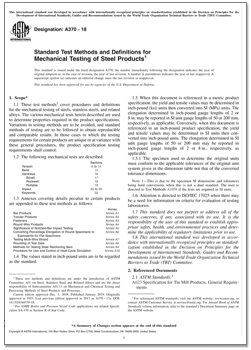英文名称:
ASTM A370-19
Standard Test Methods and Definitions for Mechanical Testing of Steel Products
中文名称:
ASTM A370-19
钢铁产品机械试验的标准试验方法及定义
替代情况:替代ASTM A370-17
代号说明:
This standard is issued under the fixed designation A370; the number immediately following the designation indicates the year of original adoption or, in the case of revision, the year of last revision. A number in parentheses indicates the year of last reapproval. A superscript epsilon (ε) indicates an editorial change since the last revision or reapproval.
This standard has been approved for use by agencies of the U.S. Department of Defense.
版本说明:
1 These test methods and definitions are under the jurisdiction of ASTM Committee A01 on Steel, Stainless Steel and Related Alloys and are the direct responsibility of Subcommittee A01.13 on Mechanical and Chemical Testing and Processing Methods of Steel Products and Processes.
Current edition approved Dec. 1, 2018. Published January 2019. Originally approved in 1953. Last previous edition approved in 2017 as A370 – 17a. DOI:10.1520/A0370-18.
2 For ASME Boiler and Pressure Vessel Code applications see related Specification SA-370 in Section II of that Code.
3 For referenced ASTM standards, visit the ASTM website, www.astm.org, or contact ASTM Customer Service at service@astm.org. For Annual Book of ASTM Standards volume information, refer to the standard’s Document Summary page on the ASTM website.
标准正文:
1. Scope
1.1 These test methods 2 cover procedures and definitions for the mechanical testing of steels, stainless steels, and related alloys. The various mechanical tests herein described are used to determine properties required in the product specifications. Variations in testing methods are to be avoided, and standard methods of testing are to be followed to obtain reproducible and comparable results. In those cases in which the testing requirements for certain products are unique or at variance with these general procedures, the product specification testing requirements shall control.
1.2 The following mechanical tests are described:
Sections
Tension 6 to 14
Bend 15
Hardness 16
Brinell 17
Rockwell 18
Portable 19
Impact 20 to 30
Keywords 32
1.3 Annexes covering details peculiar to certain products are appended to these test methods as follows:
Annex
Bar Products Annex A1
Tubular Products Annex A2
Fasteners Annex A3
Round Wire Products Annex A4
Significance of Notched-Bar Impact Testing Annex A5
Converting Percentage Elongation of Round Specimens to Equivalents for Flat Specimens Annex A6
Testing Multi-Wire Strand Annex A7
Rounding of Test Data Annex A8
Methods for Testing Steel Reinforcing Bars Annex A9
Procedure for Use and Control of Heat-Cycle Simulation Annex A10
1.4 The values stated in inch-pound units are to be regarded as the standard.
1.5 When this document is referenced in a metric product specification, the yield and tensile values may be determined in inch-pound (ksi) units then converted into SI (MPa) units. The elongation determined in inch-pound gauge lengths of 2 or 8 in. may be reported in SI unit gauge lengths of 50 or 200 mm, respectively, as applicable. Conversely, when this document is referenced in an inch-pound product specification, the yield and tensile values may be determined in SI units then converted into inch-pound units. The elongation determined in SI unit gauge lengths of 50 or 200 mm may be reported in inch-pound gauge lengths of 2 or 8 in., respectively, as applicable.
1.5.1 The specimen used to determine the original units must conform to the applicable tolerances of the original unit system given in the dimension table not that of the converted tolerance dimensions.
NOTE 1—This is due to the specimen SI dimensions and tolerances being hard conversions when this is not a dual standard. The user is directed to Test Methods A1058 if the tests are required in SI units.
1.6 Attention is directed to ISO/IEC 17025 when there may be a need for information on criteria for evaluation of testing laboratories.
1.7 This standard does not purport to address all of the safety concerns, if any, associated with its use. It is the responsibility of the user of this standard to establish appropriate safety, health, and environmental practices and determine the applicability of regulatory limitations prior to use.
1.8 This international standard was developed in accordance with internationally recognized principles on standardization established in the Decision on Principles for the Development of International Standards, Guides and Recommendations issued by the World Trade Organization Technical Barriers to Trade (TBT) Committee.
2. Referenced Documents
2.1 ASTM Standards:
A623 Specification for Tin Mill Products, General Requirements
A623M Specification for Tin Mill Products, General Requirements [Metric]
A833 Test Method for Indentation Hardness of Metallic Materials by Comparison Hardness Testers
A956/A956M Test Method for Leeb Hardness Testing of Steel Products
A1038 Test Method for Portable Hardness Testing by the Ultrasonic Contact Impedance Method
A1058 Test Methods for Mechanical Testing of Steel Products—Metric
A1061/A1061M Test Methods for Testing Multi-Wire Steel Prestressing Strand
E4 Practices for Force Verification of Testing Machines
E6 Terminology Relating to Methods of Mechanical Testing
E8/E8M Test Methods for Tension Testing of Metallic Materials
E10 Test Method for Brinell Hardness of Metallic Materials
E18 Test Methods for Rockwell Hardness of Metallic Materials
E23 Test Methods for Notched Bar Impact Testing of Metallic Materials
E29 Practice for Using Significant Digits in Test Data to Determine Conformance with Specifications
E83 Practice for Verification and Classification of Extensometer Systems
E110 Test Method for Rockwell and Brinell Hardness of Metallic Materials by Portable Hardness Testers
E190 Test Method for Guided Bend Test for Ductility of Welds
E290 Test Methods for Bend Testing of Material for Ductility
2.2 ASME Document:
ASME Boiler and Pressure Vessel Code, Section VIII,Division I, Part UG-8
2.3 ISO Standard:
ISO/IEC 17025 General Requirements for the Competence of Testing and Calibration Laboratories
在线阅读 免费下载







